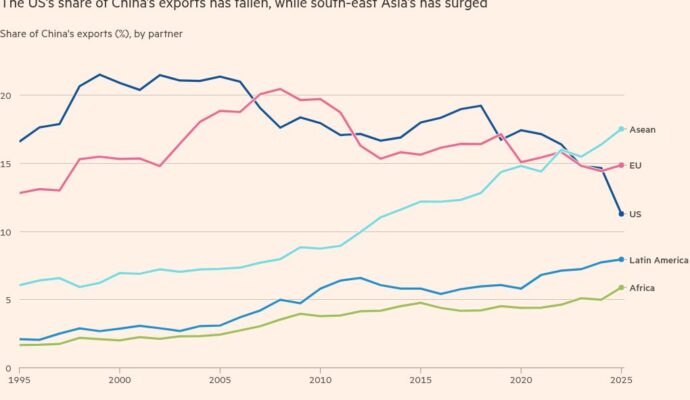Stay informed with free updates
Simply sign up to the Chinese economy myFT Digest — delivered directly to your inbox.
China’s economy remained mired in deflation last month, official data showed on Wednesday, highlighting the challenge for policymakers eager to boost domestic demand as trade tensions escalate with the US.
The producer price index, which measures factory gate prices and has been negative for three straight years, last month declined 2.3 per cent year-on-year, compared with a 2.9 per cent drop in August.
China’s consumer price index fell 0.3 per cent, marginally less than economist forecasts, after a 0.4 per cent decline last month. The index has been positive in only two months this year.
The weak data comes at a time when persistent downward price pressure has driven concerns over the strength of consumer demand in the mainland.
Consumers have been reluctant to spend since the end of the Covid-19 pandemic while government support measures have struggled to offset the impact of a four-year property slowdown.
China’s Golden Week holiday at the start of October saw huge numbers of travellers but there were signs consumers were opting for cheaper alternatives. The government has launched trade-in programmes for consumer appliances and other goods to support spending but falling home prices have weighed on confidence.
Inflation data has also added to concerns about overcapacity across China’s vast industrial sector.
President Xi Jinping has spearheaded a campaign to cut down on neijuan, or “involution”, a term that refers to self-harming competition and is seen to afflict a wide range of sectors and businesses.
Factory activity has also contracted for the past six months, the longest decline in six years and a sign of pressure from a trade war with the US.
Tensions between Washington and Beijing have escalated in recent days after China said it would expand rare-earth controls and US President Donald Trump threatened to increase tariffs by 100 per cent.
The decline in producer prices was the least in seven months, in a sign of a potential impact of official curbs on output. While the overall CPI index continued to decline, core CPI, which excludes food and energy, rose 1 per cent in September.
Lynn Song, chief China economist at ING, said that a drag on food prices drove overall deflation. “If the recovery of non-food prices is sustained, it would go a long way toward pushing China out of deflationary territory,” he said.
“Another month of deflation suggests that monetary policy easing remains on the table,” he added.


